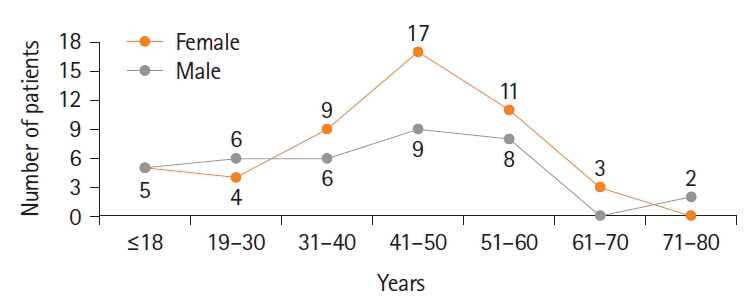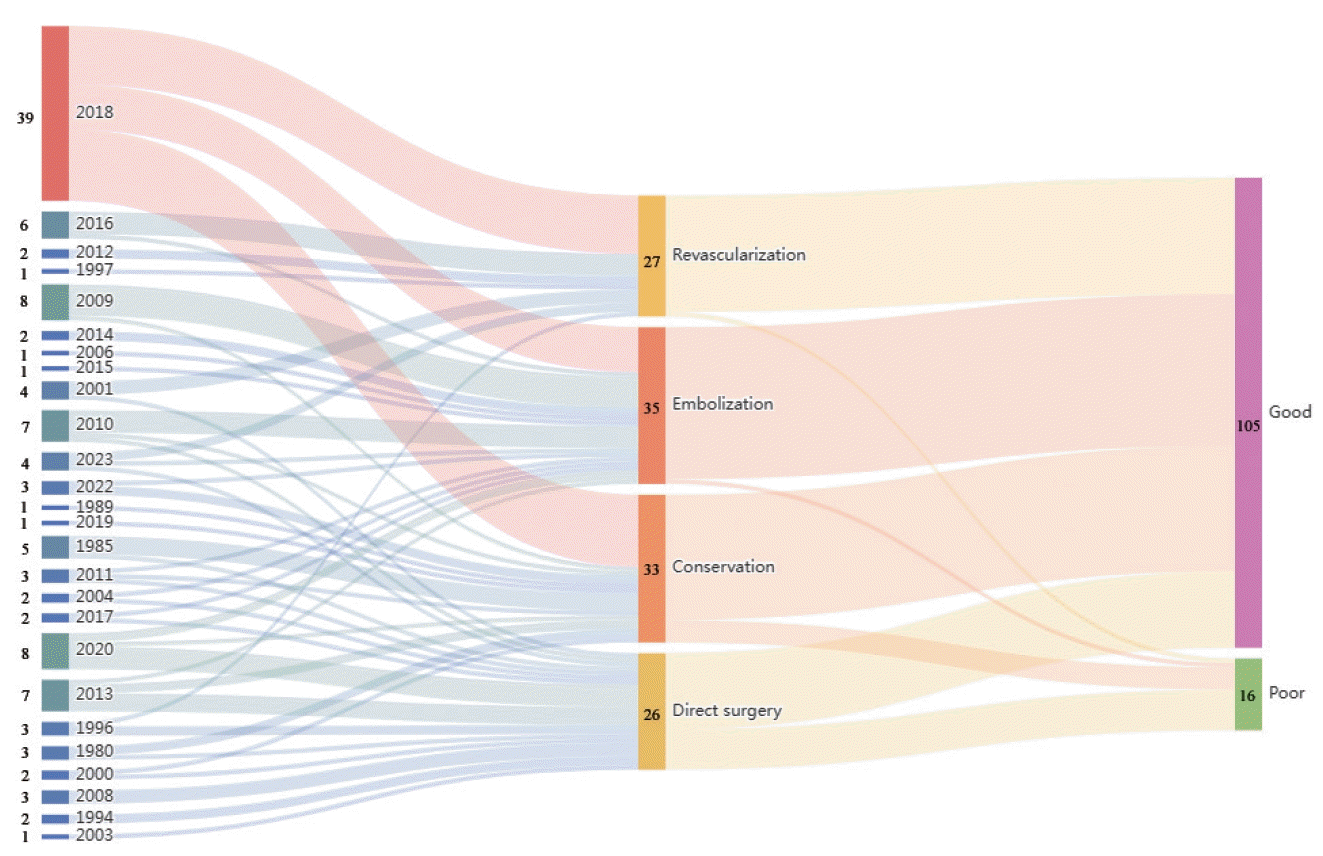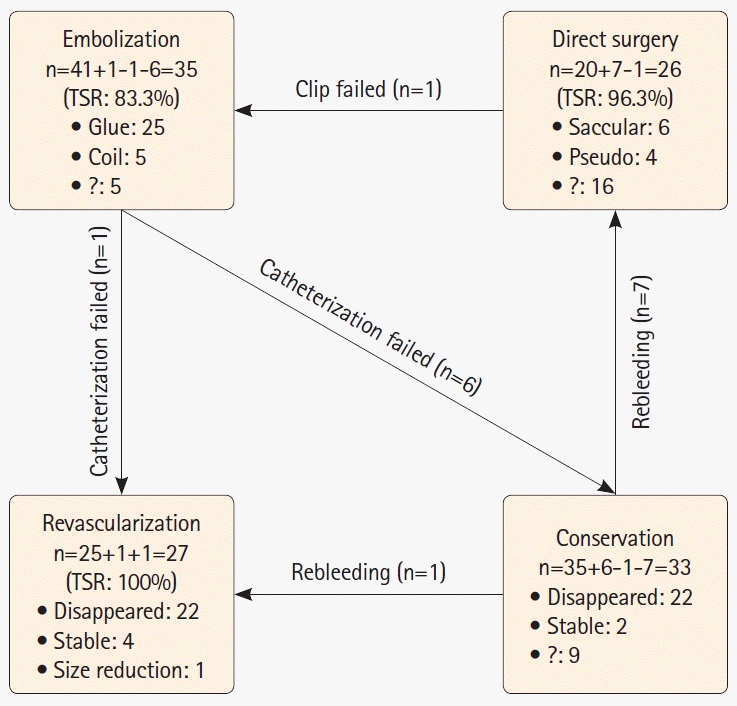1. Larson AS, Rinaldo L, Brinjikji W, Lanzino G. Location-based treatment of intracranial aneurysms in moyamoya disease: a systematic review and descriptive analysis. Neurosurg Rev. 2021; 44:1127–1139.

2. Ni W, Jiang H, Xu B, Lei Y, Yang H, Su J, et al. Treatment of aneurysms in patients with moyamoya disease: a 10-year single-center experience. J Neurosurg. 2018; 128:1813–1822.

3. Kim S, Jang CK, Park EK, Shim KW, Kim DS, Chung J, et al. Clinical features and outcomes of intracranial aneurysm associated with moyamoya disease. J Clin Neurol. 2020; 16:624–632.

4. Yoshida Y, Yoshimoto T, Shirane R, Sakurai Y. Clinical course, surgical management, and long-term outcome of moyamoya patients with rebleeding after an episode of intracerebral hemorrhage: an extensive follow-up study. Stroke. 1999; 30:2272–2276.
5. Kim SH, Kwon OK, Jung CK, Kang HS, Oh CW, Han MH, et al. Endovascular treatment of ruptured aneurysms or pseudoaneurysms on the collateral vessels in patients with moyamoya disease. Neurosurgery. 2009; 65:1000–1004.

6. Okawa M, Abe H, Ueba T, Higashi T, Inoue T. Surgical management of a ruptured posterior choroidal intraventricular aneurysm associated with moyamoya disease. Cent Eur J Med. 2013; 8:818–821.

7. Kim JH, Kwon TH, Kim JH, Chong K, Yoon W. Intracranial aneurysms in adult moyamoya disease. World Neurosurg. 2018; 109:e175–e182.

8. Yamada H, Saga I, Kojima A, Horiguchi T. Short-term spontaneous resolution of ruptured peripheral aneurysm in moyamoya disease. World Neurosurg. 2019; 126:247–251.

9. Arai Y, Matsuda K, Isozaki M, Nakajima T, Kikuta K. Ruptured intracranial aneurysms associated with moyamoya disease: three case reports. Neurol Med Chir (Tokyo). 2011; 51:774–776.
10. Ali MJ, Bendok BR, Getch CC, Gottardi-Littell NR, Mindea S, Batjer HH. Surgical management of a ruptured posterior choroidal intraventricular aneurysm associated with moyamoya disease using frameless stereotaxy: case report and review of the literature. Neurosurgery. 2004; 54:1019–1024.

11. Tanaka Y, Takeuchi K, Akai K. Intracranial ruptured aneurysm accompanying moyamoya phenomenon. Acta Neurochir (Wien). 1980; 52:35–43.

12. Konishi Y, Kadowaki C, Hara M, Takeuchi K. Aneurysms associated with moyamoya disease. Neurosurgery. 1985; 16:484–491.

13. Grabel JC, Levine M, Hollis P, Ragland R. Moyamoya-like disease associated with a lenticulostriate region aneurysm: case report. J Neurosurg. 1989; 70:802–803.

14. Hamada J, Hashimoto N, Tsukahara T. Moyamoya disease with repeated intraventricular hemorrhage due to aneurysm rupture: report of two cases. J Neurosurg. 1994; 80:328–331.
15. Kawaguchi S, Sakaki T, Morimoto T, Kakizaki T, Kamada K. Characteristics of intracranial aneurysms associated with moyamoya disease: a review of 111 cases. Acta Neurochir (Wien). 1996; 138:1287–1294.

16. Kawai K, Narita K, Nakayama H, Tamura A. Ventricular hemorrhage at an early stage of moyamoya disease—case report. Neurol Med Chir (Tokyo). 1997; 37:184–187.

17. Miyake H, Ohta T, Kajimoto Y, Ogawa R, Deguchi J. Intraventricular aneurysms—three case reports. Neurol Med Chir (Tokyo). 2000; 40:55–60.
18. Lee JK, Lee JH, Kim SH, Lee MC. Distal anterior choroidal artery aneurysm in a patient with moyamoya disease: case report. Neurosurgery. 2001; 48:222–225.

19. Kuroda S, Houkin K, Kamiyama H, Abe H. Effects of surgical revascularization on peripheral artery aneurysms in moyamoya disease: report of three cases. Neurosurgery. 2001; 49:463–467. discussion 467-468.
20. Wong GK, Boet R, Poon WS. Ruptured distal anterior choroidal artery aneurysm presenting with right intracerebral haematoma: clipping aided by subpial uncal resection. J Clin Neurosci. 2003; 10:689–691.
21. Koebbe CJ, Horowitz MB. A rare case of a ruptured middle meningeal aneurysm causing intracerebral hematoma in a patient with moyamoya disease. AJNR Am J Neuroradiol. 2004; 25:574–576.
22. Baik SK, Kim YS, Lee HJ, Kim IS, Kang DS. Endovascular management of peripheral lateral posterior choroidal artery aneurysm associated with moyamoya disease: case report and review of the literature. Neurointervention. 2006; 1:44–49.
23. Gandhi CD, Gilad R, Patel AB, Haridas A, Bederson JB. Treatment of ruptured lenticulostriate artery aneurysms. J Neurosurg. 2008; 109:28–37.
24. Choulakian A, Drazin D, Alexander MJ. NBCA embolization of a ruptured intraventricular distal anterior choroidal artery aneurysm in a patient with moyamoya disease. J Neurointerv Surg. 2010; 2:368–370.
25. Park YS, Suk JS, Kwon JT. Repeated rupture of a middle meningeal artery aneurysm in moyamoya disease: case report. J Neurosurg. 2010; 113:749–752.

26. Leung GK, Lee R, Lui WM, Hung KN. Thalamo-perforating artery aneurysm in moyamoya disease–case report. Br J Neurosurg. 2010; 24:479–481.
27. Yang S, Yu JL, Wang HL, Wang B, Luo Q. Endovascular embolization of distal anterior choroidal artery aneurysms associated with moyamoya disease. A report of two cases and a literature review. Interv Neuroradiol. 2010; 16:433–441.

28. Yu JL, Wang HL, Xu K, Li Y, Luo Q. Endovascular treatment of intracranial aneurysms associated with moyamoya disease or moyamoya syndrome. Interv Neuroradiol. 2010; 16:240–248.

29. Lévêque M, McLaughlin N, Laroche M, Bojanowski MW. Endoscopic treatment of distal choroidal artery aneurysm. J Neurosurg. 2011; 114:116–119.
30. Xu HW, Li MH, Guan S, Sun SL. Two different methods of endovascular treatment for ruptured intracranial aneurysm associated with moyamoya disease and review of the literature. Life Sci J. 2011; 8:386–389.
31. Ni W, Xu F, Xu B, Liao Y, Gu Y, Song D. Disappearance of aneurysms associated with moyamoya disease after STA-MCA anastomosis with encephaloduro myosynangiosis. J Clin Neurosci. 2012; 19:485–487.

32. Hayashi K, Horie N, Nagata I. A case of unilateral moyamoya disease suffered from intracerebral hemorrhage due to the rupture of cerebral aneurysm, which appeared seven years later. Surg Neurol Int. 2013; 4:17.

33. Chalouhi N, Tjoumakaris S, Gonzalez LF, Dumont AS, Shah Q, Gordon D, et al. Onyx embolization of a ruptured lenticulostriate artery aneurysm in a patient with moyamoya disease. World Neurosurg. 2013; 80:436.e7–436.e10.

34. Okamura K, Higuchi T, Izumo T, Takahira R, Sadakata E, Yoshida M, et al. Ruptured basilar artery perforator aneurysm: a novel mechanism of pure subarachnoid hemorrhage in moyamoya disease. Illustrative case. J Neurosurg Case Lessons. 2022; 4:CASE22238.
35. He K, Zhu W, Chen L, Mao Y. Management of distal choroidal artery aneurysms in patients with moyamoya disease: report of three cases and review of the literature. World J Surg Oncol. 2013; 11:187.

36. Yuan Z, Woha Z, Weiming X. Intraventricular aneurysms: case reports and review of the literature. Clin Neurol Neurosurg. 2013; 115:57–64.

37. Hwang K, Hwang G, Kwon OK. Endovascular embolization of a ruptured distal lenticulostriate artery aneurysm in patients with moyamoya disease. J Korean Neurosurg Soc. 2014; 56:492–495.

38. Daou B, Chalouhi N, Tjoumakaris S, Rosenwasser RH, Jabbour P. Onyx embolization of a ruptured aneurysm in a patient with moyamoya disease. J Clin Neurosci. 2015; 22:1693–1696.

39. Liu P, Lv XL, Liu AH, Chen C, Ge HJ, Jin HW, et al. Intracranial aneurysms associated with moyamoya disease in children: clinical features and long-term surgical outcome. World Neurosurg. 2016; 94:513–520.
40. Kim YS, Joo SP, Lee GJ, Park JY, Kim SD, Kim TS. Ruptured choroidal artery aneurysms in patients with moyamoya disease: two case series and review of the literatures. J Clin Neurosci. 2017; 44:236–239.

41. Rhim JK, Cho YD, Jeon JP, Yoo DH, Cho WS, Kang HS, et al. Ruptured aneurysms of collateral vessels in adult onset moyamoya disease with hemorrhagic presentation. Clin Neuroradiol. 2018; 28:191–199.

42. Tokairin K, Kazumata K, Gotoh S, Sugiyama T, Kobayashi H. Neuroendoscope-assisted aneurysm trapping for ruptured intraventricular aneurysms in moyamoya disease patients. World Neurosurg. 2020; 141:278–283.

43. Zhao X, Wang X, Wang M, Meng Q, Wang C. Treatment strategies of ruptured intracranial aneurysms associated with moyamoya disease. Br J Neurosurg. 2021; 35:209–215.

44. Larson A, Rinaldo L, Brinjikji W, Meyer F, Lanzino G. Intracranial aneurysms in white patients with moyamoya disease: a U.S. single-center case series and review. World Neurosurg. 2020; 138:e749–e758.
45. Goto Y, Oka H, Hino A. Managing intervention for severe intraventricular hemorrhage casting in moyamoya disease: report of two cases. Int J Surg Case Rep. 2020; 73:271–276.

46. Byeon Y, Kim HB, You SH, Yang K. A ruptured lenticulostriate artery aneurysm in moyamoya disease treated with Onyx embolization. J Cerebrovasc Endovasc Neurosurg. 2022; 24:154–159.

47. Fu C, Jiang P, Zhao Y, Li Y. Recurrent artery of heubner aneurysm masquerading as caudate hemorrhage without subarachnoid hemorrhage in moyamoya disease: a case report and literature review. Curr Med Imaging. 2022; 18:429–431.

48. Kusakabe T, Oda K, Kobayashi H, Kawano D, Yoshinaga S, Fukumoto H, et al. Disappearance of a moyamoya-related distal anterior cerebral artery aneurysm after target bypass revascularization: illustrative case. J Neurosurg Case Lessons. 2023; 6:CASE23200.

49. Lee GY, Cho BK, Hwang SH, Roh H, Kim JH. Hydration-induced rapid growth and regression after indirect revascularization of an anterior choroidal artery aneurysm associated with moyamoya disease: a case report. J Cerebrovasc Endovasc Neurosurg. 2023; 25:75–80.
50. Ding W, Zhao Y, Liu L, Wang P, Qiu W, Ren H, et al. Moyamoya disease with distal anterior choroidal artery aneurysm resected via transcallosal approach: a case report and review. Medicine (Baltimore). 2023; 102:e33973.

51. Ando M, Maki Y, Hojo M, Hatano T. Ruptured saccular aneurysm of the lenticulostriate artery embolized without parent artery occlusion in a case of moyamoya disease. Neuroradiol J. 2023; 36:108–111.

52. Funaki T, Takahashi JC, Houkin K, Kuroda S, Takeuchi S, Fujimura M, et al. Angiographic features of hemorrhagic moyamoya disease with high recurrence risk: a supplementary analysis of the Japan adult moyamoya trial. J Neurosurg. 2018; 128:777–784.

53. Fujimura M, Funaki T, Houkin K, Takahashi JC, Kuroda S, Tomata Y, et al. Intrinsic development of choroidal and thalamic collaterals in hemorrhagic-onset moyamoya disease: casecontrol study of the Japan adult moyamoya trial. J Neurosurg. 2019; 130:1453–1459.

54. Wiedmann MKH, Davidoff C, Lo Presti A, Ni W, Rhim JK, Simons M, et al. Treatment of ruptured aneurysms of the choroidal collateral system in moyamoya disease: a systematic review and data analysis. J Neurosurg. 2021; 136:637–646.
55. Sato Y, Kazumata K, Nakatani E, Houkin K, Kanatani Y. Characteristics of moyamoya disease based on national registry data in Japan. Stroke. 2019; 50:1973–1980.

56. Ge P, Ye X, Zhang Q, Liu X, Deng X, Zhao M, et al. Clinical features, surgical treatment, and outcome of intracranial aneurysms associated with moyamoya disease. J Clin Neurosci. 2020; 80:274–279.

57. Saeki N, Nakazaki S, Kubota M, Yamaura A, Hoshi S, Sunada S, et al. Hemorrhagic type moyamoya disease. Clin Neurol Neurosurg. 1997; 99(Suppl 2):S196–S201.

58. Kobayashi E, Saeki N, Oishi H, Hirai S, Yamaura A. Long-term natural history of hemorrhagic moyamoya disease in 42 patients. J Neurosurg. 2000; 93:976–980.

59. Iwama T, Morimoto M, Hashimoto N, Goto Y, Todaka T, Sawada M. Mechanism of intracranial rebleeding in moyamoya disease. Clin Neurol Neurosurg. 1997; 99(Suppl 2):S187–S190.
60. Yan J, Lv M, Zeng E, Tang B, Xie S, Hong T. Clinical features and prognostic analysis of moyamoya disease associated with intracranial aneurysms. Neurol Res. 2020; 42:767–772.

61. Eguchi H, Arai K, Kawamata T. Aneurysm appearing at the anastomosis site 11 years after superficial temporal arterymiddle cerebral artery bypass surgery: moyamoya disease with a rapidly growing aneurysm. Illustrative case. J Neurosurg Case Lessons. 2023; 6:CASE23529.

62. Kondo K, Hara S, Kaneoka A, Inaji M, Tanaka Y, Nariai T, et al. Spontaneous occlusion of ruptured microaneurysm formed on postoperative transosseous anastomosis after indirect revascularization in a patient with moyamoya disease. Acta Neurochir (Wien). 2024; 166:206.

63. Nishimoto T, Yuki K, Sasaki T, Murakami T, Kodama Y, Kurisu K. A ruptured middle cerebral artery aneurysm originating from the site of anastomosis 20 years after extracranial-intracranial bypass for moyamoya disease: case report. Surg Neurol. 2005; 64:261–265.

64. Eom KS, Kim DW, Kang SD. Intracerebral hemorrhage caused by rupture of a giant aneurysm complicating superficial temporal artery-middle cerebral artery anastomosis for moyamoya disease. Acta Neurochir (Wien). 2010; 152:1069–1073.
65. Fukushima Y, Miyawaki S, Inoue T, Shimizu S, Yoshikawa G, Imai H, et al. Repeated de novo aneurysm formation after anastomotic surgery: potential risk of genetic variant RNF213 c.14576G>A. Surg Neurol Int. 2015; 6:41.

66. Yokota H, Yokoyama K, Noguchi H. De novo aneurysm associated with superficial temporal artery to middle cerebral artery bypass: report of two cases and review of literature. World Neurosurg. 2016; 92:583.e7–583.e12.

67. Aburakawa D, Fujimura M, Niizuma K, Sakata H, Endo H, Tominaga T. Navigation-guided clipping of a de novo aneurysm associated with superficial temporal artery-middle cerebral artery bypass combined with indirect pial synangiosis in a patient with moyamoya disease. Neurosurg Rev. 2017; 40:517–521.

68. Takahashi H, Baba Y, Usui R, Ohkuchi A, Kijima S, Matsubara S. Spontaneous resolution of post-delivery or post-abortion uterine artery pseudoaneurysm: a report of three cases. J Obstet Gynaecol Res. 2016; 42:730–733.

69. Muroya T, Ogura H, Shimizu K, Tasaki O, Kuwagata Y, Fuse T, et al. Delayed formation of splenic pseudoaneurysm following nonoperative management in blunt splenic injury: multiinstitutional study in Osaka, Japan. J Trauma Acute Care Surg. 2013; 75:417–420.




 PDF
PDF Citation
Citation Print
Print







 XML Download
XML Download